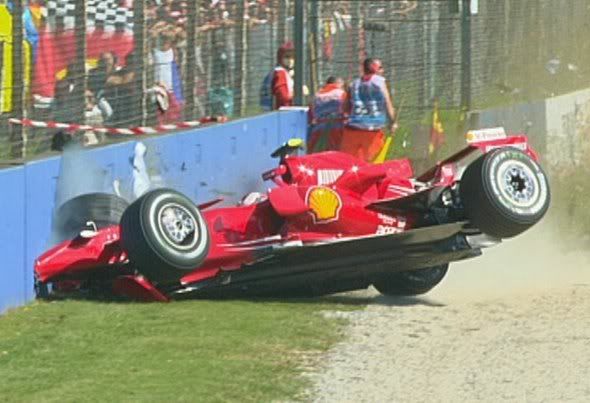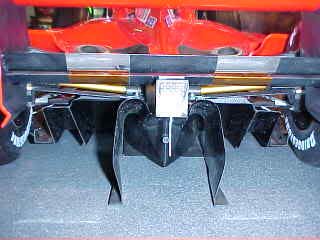September 08, 2007

According to FIA regulations, the undertray of a F1 car must be flat from side to side and between the axles, save for the FIA legality plank. In the picture above, you can see the plank in the middle of the tray.
Steven asks: "I'm surprised to see that it's very flat, though I probably should not be. That's to limit the amount of turbulence drag under the car as it drives, right?"
Partially! Yes, it does cut down on the drag, but it's also to prevent the rebirth of ground-effect tunnels. Back in the heady days of the aerodynamic revolution, some clever designers came up with the idea of using ground effect skirts and tunnels to increase grip. They succeeded so well that if it hadn't've been banned, we'd be seeing F1 cars taking whole tracks flat-out (except for the sharpest turns and chicanes). So the flat undertray does not allow for the ground effect tunnels (though the whole flexible floor kerfluffle from the beginning of the season makes me wonder). There IS some downforce created by the undertray. However more of it is generated, not by the undertray, but by the diffuser at the back of the car. The undertray of the car angles up sharply once you get past the rear axle, and is channeled by the most secretive part of the F1 car, the rear diffuser. How secretive? The only good pictures I could find are either of models or of older cars!

The above photo, from a 1/4-scale replica of a Ferrari, shows the channels of the rear diffuser. When the air zips out the back of a car via the diffuser, downforce is created via the channels (any CFD experts out there???) via aerodynamic forces... which I can't explain as it's wayyyy above my paygrade.

In this heavily de-contrasted and brightened picture, you can see the diffuser directly under the rear wing. I've just found this explanation of what a diffuser does, at symscape.com
"The air enters the diffuser in a low-pressure, high-velocity state after accelerating under the car. By gradually increasing the cross-sectional area of the diffuser, the air gradually slows down and returns to its original free-stream speed and pressure. The diffuser's aim is to decelerate the air without it separating from the tunnel walls, which would cause a stall, reducing the downforce and inducing a large drag force. By installing an inverted wing close to the diffuser exit it is possible to create a low-pressure area, which essentially sucks the air from the diffuser. The diffuser and wing combination permits a higher air-mass-flow rate through the diffuser, thus resulting in higher downforce.
Got that? The flat undertray accelerates the air under the car, the diffuser slows it down and funnels it to the rear wing... causing suckage towards the ground. I think. Maybe. Huh?
Oh, the legality plank? It's a piece of wood bolted to the bottom of a F1 car. It's there to set a minimum ride height. If the car runs too low, the plank is worn away; if it gets worn down 1mm, the car is excluded.
Right. That's the story of the undertray and the diffuser! As always, if you know more about what/how goes on with the tray, let us know in the comments! I'll freely admit that I'm not the most knowledgable in the ways of the aerodynamicist when it comes to the underside of the car.
Posted by: Wonderduck at
07:04 PM
| Comments (2)
| Add Comment
Post contains 611 words, total size 4 kb.
The bad news is that if the air that is exiting behind the car gets all turbulent, then there will be backforce on the car, increased drag. It sounds like the purpose of the diffuser is to get the air out smoothly so it doesn't become turbulent -- or at least, so it waits long enough in doing so that it no longer affects the car by increasing drag.
Posted by: Steven Den Beste at September 08, 2007 07:19 PM (+rSRq)
It's amazing, really. F1 cars are so frickin' advanced these days that it's nigh impossible for someone to keep track of it all.
It doesn't help that the diffuser is one of the few things a team can keep secret, since it's part of the underside of the car... and the only time you see that is when the car is airborne or upside down.
Posted by: Wonderduck at September 08, 2007 07:25 PM (M7kiy)
47 queries taking 0.0697 seconds, 235 records returned.
Powered by Minx 1.1.6c-pink.









